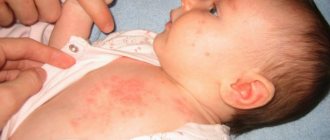Causes of allergies
The main causes of allergies (including to corn) include:
- use of antibiotics by a woman during pregnancy and breastfeeding,
- improper introduction of complementary foods,
- unfavorable environmental situation,
- consumption by a pregnant woman of products containing additives in the form of preservatives and flavorings.
The main allergens found in corn are the proteins zein and glutelin.
Usually, corn porridge is one of the first introduced as complementary foods. This is explained by the fact that it is usually perfectly absorbed. But can corn porridge cause allergies in infants? Unfortunately yes. There are two possibilities:
- If an allergic reaction occurs to corn from a bag, then the cause may be not only the cereal itself, but also various additives.
- If the porridge was cooked from natural corn grits without adding oil and sugar, it makes sense to talk about a true allergy to corn.
It spilled onto corn or some other component of the porridge - only an allergist can determine it using special tests.
Sometimes cross-allergy to corn occurs. It can occur in people who are sensitive to grain pollen.
There is also an allergy to cereal starch, including corn.
Allergens
Corn includes both food and pollen allergens.
Pollen
- Zea m 1 – group 1 herbal allergens;
- Zea m 2 – group 2 herbal allergens;
- Zea m 3 – expansin;
- Zea m 4 – group 4 herbal allergens, pectate lyase;
- Zea m 5 is a protein with unknown biological function;
- Zea m 7 – calcium-binding protein;
- Zea m 11 – trypsin inhibitor, found in seeds and pollen;
- Zea m 12 – profilin – cross allergen;
- Zea m 13 – group 13 herbal allergens, polygalacturonase;
- Zea m Zm13 is a protein associated with the olive pollen allergen.
Food
- Zea m 14 is a lipid transfer protein (LTP). Main allergen;
- Zea m 25 – thioredoxin;
- Zea m 27kD, Zea m 50kD – zein.
The lipid transfer protein Zea m 14 was isolated from corn flour. Traditionally, it is extremely heat stable and even heat treatment at 100 °C for 160 minutes does not significantly reduce its allergenic properties.
Zea m 14 is a dangerous allergen, 85% responsible for serious systemic reactions in the body.
Thus, BPL is most likely the cause of allergies to both raw and cooked corn.
Zea m 50kD is also resistant to heat and digestion.
In addition to the above, corn seeds contain profilin, but in much smaller quantities than in pollen and vegetables such as celery and tomatoes. This profilin may have low clinical value because it is destroyed by heat treatment.
However, the presence of profilin in corn seeds may play a role in the occurrence of occupational asthma, where inhalation of corn flour or dust is possible.
Cross-reactivity (food)
Cross-reactivity can be demonstrated among different cereal crops. This especially applies to professional reactions – for example, among bakers.
| Titles | |
| Cereals | Wheat, triticale, rye, barley, oats, rice, corn |
The main food allergen in corn is lipid transfer protein (LTP). It exhibits a high degree of cross-reactivity.
| Titles | |
| Plants with BPL | Peach, apple, walnut. hazelnuts, peanuts, corn, rice, sunflower seeds, beans, apricot. |
Not all plant BPLs are closely related to each other.
For example, ripe cherries show up to 88% identity with peach and apricot and only 59% with corn. Corn protein reacts similarly with peach and rice, but not with wheat or barley BPL.
It is important to note that people with a corn pollen allergy may also demonstrate an allergy to corn seeds.
Manifestations of allergies
One of the manifestations of an allergy to corn porridge in an infant is a rash on the cheeks.
Symptoms of an allergy to corn can be different. Manifestations of corn allergy in adults and children are:
- Rashes, blisters on the skin, eczema.
- Allergic runny nose, feeling of nasal congestion.
- Swelling of the lips, tongue and face.
- Gastrointestinal disorders (diarrhea, nausea, vomiting, abdominal pain).
- Severe headaches.
- Anaphylactic shock.
Typically, allergy symptoms develop very quickly. For this reason, it is necessary to contact an allergist as soon as possible.
Signs of a corn allergy in a child are:
- skin itching,
- rashes,
- sneezing,
- rhinitis (runny nose).
With severe allergies, nausea and vomiting may occur.
Important!
If allergy symptoms occur in an infant, you must immediately call an ambulance and take the child to the hospital to provide qualified assistance. If you do not respond to dangerous manifestations of allergies in time, serious complications can arise.
Symptoms of the disease
An allergy to cow's milk protein or another dairy product causes several symptoms of varying severity. These include both skin rashes and problems with the digestive system or respiratory tract. How does a milk allergy manifest? The easiest to notice skin manifestations are:
- red rashes (atopic dermatitis);
- rash with small dots (urticaria);
- milk scab;
- swelling of the cervical and head region (Quincke's edema).
The most dangerous is Quincke's edema.
Sodium sulfate dropper
Allergic rhinitis in a child: symptoms and treatment
General principles of corn allergy treatment
The treatment strategy for corn food allergy is developed on an individual basis. Most often, complex treatment is carried out, which includes:
- The use of medications under the control of the general condition of the patient.
- Following a hypoallergenic diet, selected individually.
Medicines are prescribed by an allergist. This is done strictly taking into account the age and condition of the patient. Antihistamines (Claritin, Suprastin, Tavegil) help cope with the symptoms of the disease, and ointments and gels eliminate skin manifestations of allergies. An alcohol solution of menthol also helps with skin itching.
Immunotherapy gives good results . This is a long-term treatment that lasts several years and consists of subcutaneously administering small doses of the allergen. This treatment is very important because corn in one form or another is found in many products, and tracking its presence can be quite difficult.
Folk remedies
Eggshells and calcium preparations are an effective folk remedy.
Many people, along with the use of medicines, use traditional medicine. Many of them really “work” and help overcome the unpleasant manifestations of allergies.
You should not self-medicate. The use of one or another folk method is permissible only with the approval of an allergist. If you find out that you are allergic to any medicinal plant, you may worsen your condition.
Eggshell
Crushed white egg shells (without heat treatment) are a good remedy for corn allergies. Extinguish 1/8 teaspoon of shell powder with two drops of freshly squeezed lemon juice (daily dose indicated).
Continue treatment until allergy symptoms disappear completely.
On the portal you can learn more about the treatment of egg shell allergies by clicking on the link
Mumiyo
It is also a good anti-allergy medicine. Dissolve a teaspoon of mumiyo in a liter of water (if the mumiyo is of good quality, it will dissolve perfectly in water). Drink 100 ml of solution every morning for a month.
Rhizomes of blood red geranium
Pour two teaspoons of crushed rhizomes into two glasses of boiling water and leave for eight hours in a dark place. Use the infusion to wipe allergy-affected skin areas.
Celery root
Grind the root in a meat grinder or in a blender (you can grate it). Squeeze the resulting mass thoroughly. Take the juice obtained in this way, two teaspoons three times a day, half an hour before meals.
Clary flowers
Take five teaspoons of dried crushed flowers, pour a glass of boiling water. Strain the broth and drink regardless of meals, and the mass can be used to lubricate itchy skin.
Liquorice root
Pour one tablespoon of crushed root into one liter of boiling water. Leave the broth for an hour, then strain. Take one glass once a day, regardless of meals.
Treatment of allergies in children
Antihistamines in the form of capsules or syrups (Zyrtec, Zodak, Fenistil) provide a good effect for relieving allergic symptoms. It must be borne in mind that antihistamines have their own age restrictions, so self-medication is unacceptable. Nasonex or Avamis drops will help cope with allergic rhinitis. Advantan or Elidep ointments are perfect for relieving skin itching.
If the allergy manifests itself as anaphylactic shock (difficulty breathing, loss of consciousness, sharp drop in blood pressure), you must immediately call an ambulance. Before the medical team arrives, the child must be placed on his back with his legs elevated.
Pharmacy tincture of calendula for skin allergies
The following folk remedies help a lot:
Dr. Komarovsky recommends wiping the affected areas of the skin with calendula tincture (sold at the pharmacy) or soda solution (dissolve 1.5 teaspoons of soda in a glass of boiled water).
These products will help dry out the allergy-affected skin a little and relieve itching.
Lubricating the inflamed areas with rosehip extract helps against allergic dermatitis.
Diagnostics
To make sure whether corn grits is an allergen or not, children and adults are tested for the presence of antibodies to corn protein. Allergies are detected through skin tests or blood tests.
Before the medical team arrives, the child must be placed on his back with his legs elevated.
Common causes of cereal allergies
The prerequisites for the development of intolerance to certain foods are laid during the period of intrauterine development. Consumption of alcohol, nicotine, medications, previous infections. Gastrointestinal diseases during pregnancy also increase the risk of the child developing hypersensitivity.
Forecast
A negative reaction to corn porridge in most cases goes away on its own closer to the age of three. This is due to the fact that by that time the formation of the baby’s digestive and immune systems is completed.
Causes of food allergies to corn elements
- Heredity.
- Bad ecology.
- Poor nutrition during pregnancy, smoking, non-compliance, use of antibiotics.
- Viral, bacterial infections.
- Chronic diseases.
- Inability to breastfeed for a long time.
- Reduced immunity.
- Complementary foods introduced ahead of schedule.
- Large first portion of complementary foods.
- Frequent changes in complementary foods.
- Milk, sugar, fruits, preservatives, flavorings added to factory-made cereals.
- Individual intolerance to these ingredients.
Prevention
To eliminate the possibility of a corn allergy, completely eliminate foods that contain corn from your diet. A hypoallergenic diet is the most reasonable solution.
Among the prohibited foods:
- boiled, canned corn,
- corn sticks and flakes (both glazed and unglazed),
- a mixture of vegetable oils, which may contain corn oil (allergen!),
- canned and frozen vegetable mixtures,
- ready-to-eat pancakes,
- sweetened carbonated drinks (they contain corn sugar),
- beer,
- yeast,
- ready-made sauces and marinades.
Also be careful when ordering food at a restaurant. Corn is found in many Mexican and Chinese dishes.
Avoid cosmetics that contain corn (for example, cosmetics with corn silk extracts).
For a person suffering from an allergy to corn, medications in jelly capsules (carefully read the instructions for the drug), toothpaste, and vitamins are dangerous. Disposable tableware and milk cartons contain ingredients obtained from corn processing. Even glue applied to sticky surfaces (such as the glue on postage stamps) is often dangerous. Be sure to take this into account.
Mothers who are breastfeeding and if their child is allergic to corn should exclude foods with corn protein from their diet. If this is neglected, corn protein will enter the baby’s body through breast milk and again provoke an allergy.
If one of your family members suffers from allergies, you need to carefully check whether the child has this type of allergy. Some useful tips for preventing allergies
- Prepare dishes from simple ingredients. This way, you can definitely avoid ingredients containing corn.
- When purchasing cereals, be sure to ask which ones do not contain corn.
- When purchasing medications, tell the pharmacist if you have hypersensitivity. An experienced specialist will help you choose medications that do not contain corn byproducts.
- To prevent your diet from being too meager, consult a nutritionist who will help you create a varied, hypoallergenic diet.
- Check product labels to make sure the product you are purchasing does not contain corn.
How to properly introduce corn as complementary food
Corn is a valuable food product, but it must be used as complementary food very carefully so as not to cause allergies. Corn is rarely used as a first complementary food. Usually, a baby becomes familiar with corn by 8-9 months, when buckwheat and rice porridge appear in his diet.
The procedure for introducing corn porridge into complementary foods is as follows:
Start with one teaspoon. If there is no allergic reaction in the form of a rash or abdominal pain, you can increase the portion to 3-4 teaspoons the next day, gradually increasing the volume of the porridge to two hundred grams.
The benefits of corn for a baby include normalizing intestinal function, improving the functioning of the heart and blood vessels, and strengthening the immune system.
How to properly cook porridge from corn grits
In stores you can buy cereals of varying degrees of grinding, including the finest.
The cooking algorithm is as follows.
- Rinse the corn once or twice with cold water, then dry.
- Grind using a coffee grinder or blender. For children after one year of age there is no such need.
- Pour hot water over the cereal, bring to a boil and cook, stirring constantly, for fifteen to twenty minutes over low heat. It is advisable to use a non-stick pan for cooking porridge.
- In order to sweeten the porridge, it is better for children under one year old to add banana puree to it. Sugar can be used to improve taste for children over one year of age.
- The frequency of use of complementary foods is once a week.
You can cook this porridge in a double boiler, slow cooker or oven.
Only after you have made sure that your baby is not allergic to corn porridge, can you cook it with milk and please your child with a new dish.
Instant porridge
The advantage of such a product is that mothers do not need to waste time preparing a tasty and healthy dish. It is enough to pour a certain amount of the product with boiled water (you can add a little breast milk) - and the porridge is ready.
Please note that you can find both dairy-free and milk-based cereals on sale. Dairy-free is the best place to start.
Here is a review of the most common corn porridges, based on real reviews from mothers.
| Name | Description and photo |
| Bebi corn low-allergenic | Porridge, more than 92% consisting of cereals, with the addition of microelements and vitamins. This is a low-allergenic corn porridge with probiotics that improves intestinal function. It is also valuable that there are no “extra” additives for babies, such as salt and sugar, in the product. There is no need to be afraid that the porridge will seem too bland to the child: the little gourmet has not yet gotten used to the seasonings. Average cost: 130 rubles (200 grams) |
| Porridge "Malyutka" | It dissolves well, has a very pleasant, sweetish taste. Disadvantage: it contains palm oil (and this is not very good for an adult). Average cost: 110 rubles (200 grams) |
| Heinz low allergen | The name of this corn porridge speaks for itself. There are practically no disadvantages: it mixes well and children usually like it. And the absence of flavors and milk significantly reduces the risk of developing allergies. Average cost: 100 rubles (200 grams) |
Elena Malysheva about the benefits of corn grits
Is there any benefit?
This cultivated plant is rightfully considered one of the most popular cereals on earth. The first corn plantations appeared about 9 thousand years ago in Central and South America, and after the arrival of the conquerors, this tasty and healthy cereal gained popularity not only among the local population, but throughout the world.
The vitamins and microelements contained in corn are extremely beneficial for the body, namely:
- have a beneficial effect on the functioning of the cardiovascular system and brain;
- strengthen bones;
- provide hemoglobin synthesis;
- support and strengthen the immune system, etc.
Of particular value is the use of this cereal by children, since the high level of protein in its composition helps to build and strengthen the muscle corset.










